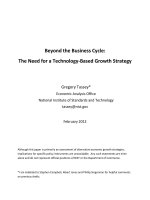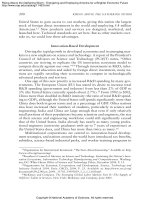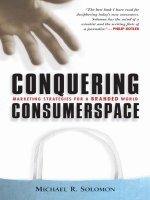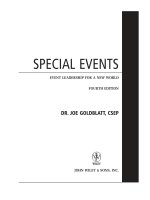Business communication developing leaders for a network world 2nd CHAPTER 5
Bạn đang xem bản rút gọn của tài liệu. Xem và tải ngay bản đầy đủ của tài liệu tại đây (1.04 MB, 69 trang )
Creating
Effective
Business
Messages
Chapter 5
© 2016 by McGraw-Hill Education. This is proprietary material solely for authorized instructor use. Not authorized for sale or distribution in any
manner. This document may not be copied, scanned, duplicated, forwarded, distributed, or posted on a website, in whole or part.
The Process for Creating
Business Messages
Writing effective business messages involves a
process—one that involves examining,
developing, and refining business ideas in a
way that provides to your audience
It drives collaboration and productivity in your
work relationships.
5-2
The Process for Creating
Business Messages
Plan
Draf
Review
5-3
The Stages and Goals of
Effective Message Creation
5-4
The Stages and Goals of
Effective Message Creation
5-5
The Stages and Goals of
Effective Message Creation
5-6
The Process for Creating
Business Messages
Expert writers are more likely to analyze the
needs of the audience, generate the best
ideas to tackle a problem, and identify the
primary message and key points before
starting a formal draft of a business message.
5-7
Time Spent by Poor, Average, and Expert Writers
Developing a Complete Business Message
Figure 5.2
5-8
The Process for Creating
Business Messages
5-9
The Process for Creating
Business Messages
5-10
The AIM Planning Process for
Business Messages
The most important stage of creating effective
business messages is planning
The AIM planning process unleashes your best
thinking and allows you to deliver influential
messages
5-11
The AIM Planning Process for
Business Messages
Figure 5.3
5-12
Audience Analysis
Effective business communicators think about
the needs, priorities, and values of their
audience members.
They envision how their readers will respond
when getting the message — in thought,
feeling, and action.
5-13
Audience Analysis
5-14
Identifying Reader Benefits
and Constraints
For many messages, this is the single most
important planning step.
Your readers respond when you provide them
with something that they value.
5-15
Considering Reader Values
and Priorities
Values
refer to enduring
beliefs and ideals that
individuals hold.
Priorities
involve ranking or
assigning importance
to things, such as
projects, goals, and
task.
5-16
Estimating Your Credibility
Your readers will judge your
recommendations, requests, and other
messages based on their view of your
credibility
Many entry-level professionals have relatively
low professional credibility because they are
viewed as the newcomers
5-17
Changing Your Reputation
Set up a time to talk with your boss
Ask your boss if you can take on any higher-responsibility
projects
Make sure you fit in with the corporate culture in terms
of professional dress and communication style.
Attend a lot of meetings to get to know as many
colleagues as possible
Create a professional blog about a niche area
5-18
The Process for Creating
Business Messages
5-19
The Process for Creating
Business Messages
5-20
Idea Development
Developing great business ideas involves:
Sorting out the business issues and objectives
Collecting as many relevant facts as possible
Making sound judgments about what the facts
mean and imply.
5-21
Idea Development
5-22
Analyzing the Business Problem(s)
Facts
statements that can be relied on with a fair
amount of certainty and can be observed
objectively
Conclusions
statements that are reasoned or deduced based
on facts.
5-23
Analyzing the Business Problem(s)
Positions
stances that you take based on a set of
conclusions.
© 2016 by McGraw-Hill Education. This is proprietary material solely for authorized instructor use. Not authorized for sale or distribution in any manner.
This document may not be copied, scanned, duplicated, forwarded, distributed, or posted on a website, in whole or part.
5-24
Clarifying Objectives:
Message Structuring
1. Framing the primary message.
a. What is the primary message?
b. What simple, vivid statement (15 words
or less) captures the essence of your
message?
5-25









